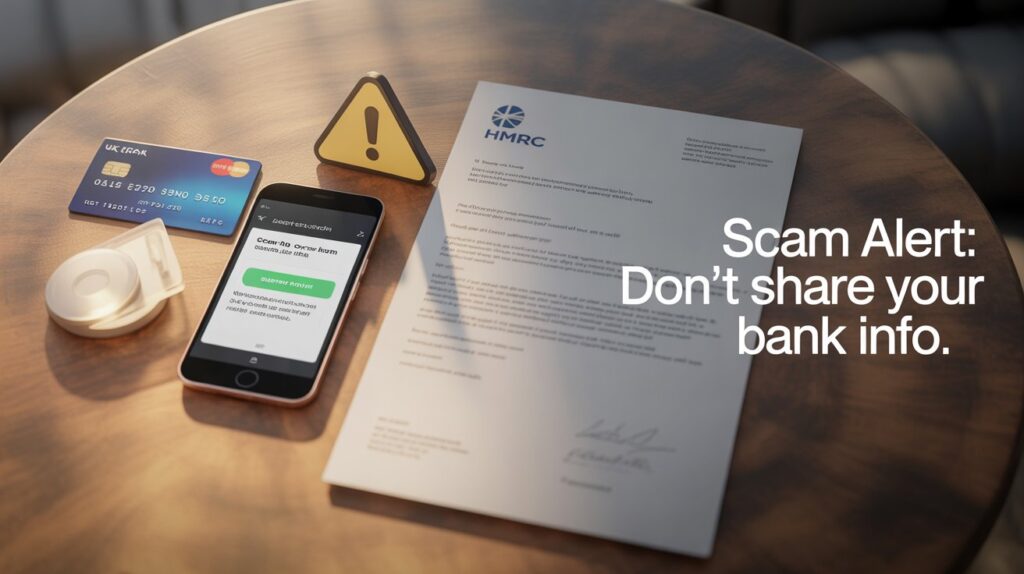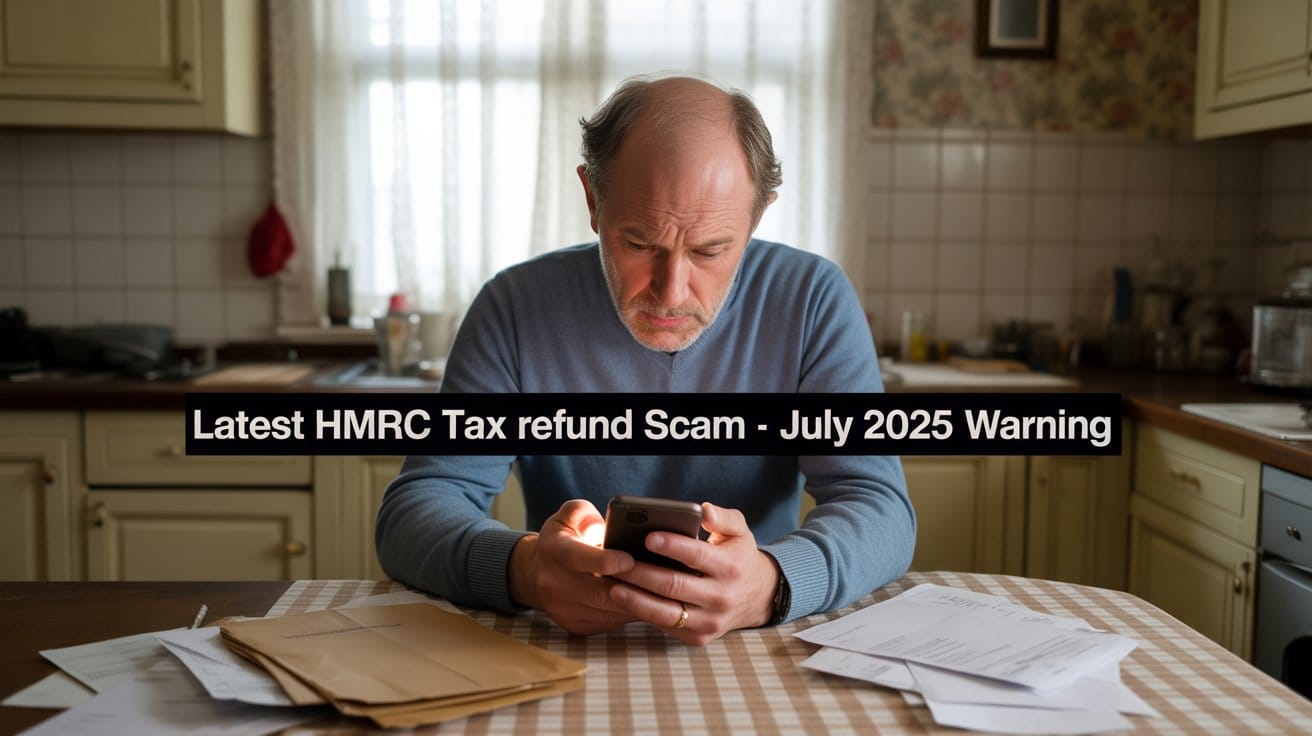🚨 “The Text That Cost Me £2,000” – Steve’s Story
The HMRC tax refund scam is back — and it’s catching thousands of UK citizens off guard this July 2025. Just ask Steve, a 38-year-old electrician from Birmingham. It was a damp Monday morning when he sipped his tea and checked his phone. A message appeared, seemingly from HMRC:
“HMRC: You’re owed a tax refund of £472.15. Click to claim your refund now – gov-uk.tax2025claims.com”
Steve had just filed his tax returns a few weeks back. He thought, “That must be it — maybe I overpaid.” The link looked official. The branding, the format — it all felt right. Without hesitation, he tapped the link, entered his details, and submitted.
Two days later, £2,000 was siphoned from his current account. The bank flagged it too late. The site he trusted? It was a complete scam.
What Is the HMRC Tax Refund Scam?
The HMRC tax refund scam is a phishing scam where fraudsters impersonate HMRC (His Majesty’s Revenue and Customs), tricking unsuspecting people into believing they’re owed a refund. It’s been around for years — but in July 2025, it’s returned with more sophistication than ever.
Using cloned websites, fake emails, spoofed phone numbers, and even WhatsApp messages, these scammers lure victims into giving away sensitive information like:
- Full names
- Date of birth
- National Insurance numbers
- Bank account details
- Taxpayer reference numbers
And in some cases, they’ll even ask for a small “processing fee” via card — a sneaky way to steal your payment details.

Why Is This Scam Booming in July?
There’s a reason this scam peaks in mid-year:
July is “refund season”.
Thousands across the UK are filing their Self Assessment corrections or chasing PAYE overpayments — and fraudsters know this. You’re already expecting something from HMRC, which makes their timing dangerously convincing.
They use psychological tactics like:
- Authority (HMRC’s name carries weight)
- Scarcity (“You have 48 hours to claim your refund”)
- Relief or excitement (“You’re owed money!”)
It’s the perfect trap.
Real Cases We’ve Heard in July 2025
🧑🎓 Ella from Leeds
A 22-year-old university student, Ella received an email from what looked like HMRC, asking her to verify her identity for a refund. The form looked real. Two days later, she couldn’t log into her online banking — her credentials had been stolen and used.
👩⚕️ Linda, a retired nurse from Essex
Linda got a phone call — the man spoke in a polite, well-spoken voice, claiming to be from the HMRC fraud department. He told her her refund was blocked due to “security concerns” and she needed to confirm her card info. She lost nearly £1,000.
How These Messages Appear
These scams come through in various forms — all carefully crafted to appear legit.
1. Email Scams
Fake emails come from addresses like:
📧 refund@hmrc-claims-gov.uk
📧 support@gov-taxrefund2025.com
They often use:
- Government logos
- Urgent subject lines: “Final Tax Refund Notice”
- Official-sounding content
- “Click to claim” buttons
2. Text Message Scams (SMS)
These might come from numbers that say “HMRC”, but they’re spoofed. They include links to phishing websites.
📝 Example:
“You have a pending tax refund. Submit your request here: gov.tax-return-refund2025.uk”
3. Phone Call Scams
Scammers are now calling directly:
- They spoof UK numbers
- They sound well-rehearsed
- Some even quote partial NI numbers (gathered from leaked data)

Red Flags to Watch Out For
- ✅ The website doesn’t end in
.gov.uk - ✅ You’re being rushed to take action
- ✅ The message mentions money or refunds without you initiating it
- ✅ There’s poor grammar or generic greetings (like “Dear Customer”)
- ✅ You’re asked for banking details, passwords, or full NI number
What HMRC Will Never Do
Let’s make this clear:
🚫 HMRC will never:
- Ask for bank details via text or email
- Offer refunds through clickable links
- Call you out of the blue demanding payment
- Contact you via WhatsApp, Telegram, or Facebook
✅ If you’re due a refund, you’ll see it on your official account at:
🔗 www.gov.uk
If You Get a Scam Message
Here’s what to do:
- Do not click any links
- Don’t reply to the sender
- Take a screenshot
- Forward suspicious emails to:
phishing@hmrc.gov.uk - Forward scam texts to:
7726(this helps your provider block the number) - Report it to Action Fraud at actionfraud.police.uk
Already Clicked? Don’t Panic. Do This Immediately:
- Contact your bank – request a freeze or block
- Change passwords for banking and email
- Run a malware scan on your device
- Enable two-factor authentication (2FA)
- Report to Action Fraud — even if you didn’t lose money
How to Stay Scam-Safe in 2025
🔐 Digital Habits You Need Today:
| Habit | Why it matters |
|---|---|
| Use strong, unique passwords | Stops credential leaks from spreading |
| Set up 2FA on everything | Adds an extra layer of security |
| Don’t click links in unexpected messages | Even if it looks official |
| Regularly update your device & apps | Patches known vulnerabilities |
| Subscribe to scam alerts | Awareness is power |
Helpful Resources
- Check for known scams
- Report fraud in the UK: www.actionfraud.police.uk
- Speak to your bank: Most banks now have dedicated scam teams — call them immediately if unsure
Final Word – Knowledge Is Your Best Protection
Scammers are clever. They’re getting better at imitating authority, exploiting trust, and pressuring victims. The latest HMRC tax refund scam is one of their most polished tricks — but it only works if we fall for it.
So next time a message offers free money or demands quick action — pause. Breathe. Ask:
Would HMRC really do this?
If you’re unsure, go directly to www.gov.uk and check your official tax account.
✅ Stay informed. Stay sceptical. Stay safe.
📣 Share Your Story
Have you received a similar scam message recently? Almost clicked it? Fell for one in the past?
Tell us in the comments below or report anonymously via our Scam Report Form. Your experience might help prevent someone else from falling victim.




